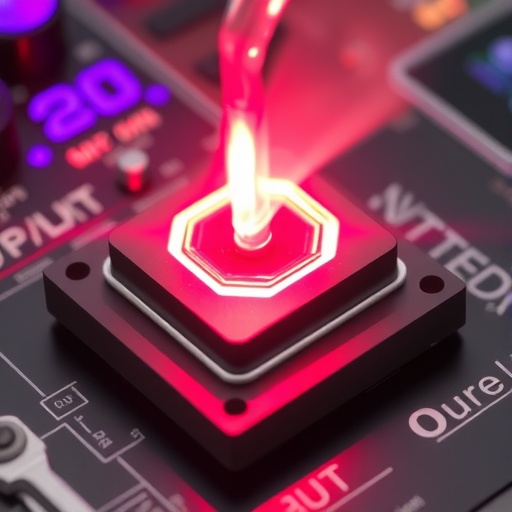Recent advancements in energy storage technologies have placed sodium-ion batteries at the forefront of research and innovation. As global energy demands elevate, these batteries present a promising solution due to their potential for cost-effectiveness and resource abundance. A pivotal study led by Ke et al. in 2025 has introduced a groundbreaking approach to enhance the performance of NaTi₂(PO₄)₃ anodes in aqueous sodium-ion batteries. This work leverages a synergistic strategy involving urea additives and carbon composites, marking a significant step forward in the optimization of sodium-ion battery technology.
In the realm of battery technology, the anode plays a critical role in determining a battery’s overall performance, including its energy capacity and efficiency. Traditionally, numerous materials have been explored as anode components for sodium-ion batteries; however, challenges remain regarding stability, conductivity, and rate capability. The NaTi₂(PO₄)₃ compound has gained traction due to its stable structure and suitable electrochemical properties, yet its performance requires enhancement for practical applications. The team’s focus on integrating a urea additive with carbon composites seeks to address these limitations effectively.
Urea, typically recognized for its application in fertilizers, has been utilized in this experimental context to modify the microstructure of the NaTi₂(PO₄)₃ anode. By creating a more conducive environment for sodium ions to move, the incorporation of urea significantly boosts the anode’s conductivity. This is a particularly important consideration given that efficient ion transport is crucial for maintaining the performance and longevity of the battery during charging and discharging cycles.
To complement the effects of the urea additive, the researchers employed carbon composites in their composite strategy. Carbon materials are known for their high conductivity and surface area. By integrating carbon into the NaTi₂(PO₄)₃ framework, the study reveals that the composite material not only enhances electron transport but also reinforces the structural integrity of the anode during cycling, mitigating the common abrasion and degradation issues that plague many battery designs.
The synergistic approach taken in this study is particularly noteworthy. The interplay between the urea additive and carbon composite strategies functions to maximize transportation efficiency for both electrons and sodium ions. The researchers conducted a series of experiments, including electrochemical impedance spectroscopy and cyclic voltammetry, which demonstrated that this composite anode configuration outperforms traditional methods in terms of charge-discharge rates and overall capacity retention.
As environmental concerns drive the shift towards sustainable energy solutions, the push for improvements in battery materials that are both efficient and eco-friendly is paramount. Sodium-ion batteries, being notably less toxic and more abundant than their lithium counterparts, are ideally positioned as a sustainable alternative. The work by Ke et al. essentially aligns with these broader objectives, highlighting the dual advantages of accessibly sourced materials and enhanced performance capabilities.
Furthermore, the significance of this novel composite approach extends beyond performance metrics. By enabling a more stable anode structure, the research has implications for the operational lifespan of sodium-ion batteries. Enhanced lifespan directly translates to a reduction in waste and a lower environmental footprint, further positioning sodium-ion technology as a vital player in the future of energy storage solutions.
In addition to technical advancements, the study sheds light on the necessary considerations for scaling up this technology for industrial applications. Researchers must assess the synthesis methods for the urea-carbon composite and ensure that the production processes are economically viable. The potential for these materials to be incorporated into current manufacturing pipelines will ultimately determine their impact on the market.
This advancement also calls for continued research into various additive and composite strategies. The performance of anodes can vary greatly depending on several factors, including temperature, humidity, and operational stress. Future studies should aim to replicate these findings under varied conditions to develop a robust understanding of all underlying mechanisms involved in these complex systems.
Moreover, this research opens the door for exploring other additives that may further optimize sodium-ion battery technology. Beyond urea, alternative nitrogenous compounds and organic additives could be studied for their potential synergistic effects in enhancing electrochemical performance. Each of these avenues presents tremendous opportunity for innovation within the realm of sodium-ion batteries.
The collective findings from the study by Ke et al. pose critical implications for energy storage research. As the world pivots towards an increased reliance on renewable energy sources, enhancing the performance and lifespan of energy storage solutions becomes imperative. The smart integration of chemically diverse components within battery anodes may represent a leading frontier in achieving efficient and eco-friendly energy storage systems.
The research community now stands at a crucial juncture, with the question remains: how will these advances influence the future landscape of energy technology? As interest and investment increase in alternative battery technologies, studies such as these highlight the potential for groundbreaking concepts and collaborations to arise, fostering a movement that further bridges the gap between scientific innovation and practical application.
Ultimately, the research led by Ke et al. offers insight into a promising approach for maximizing sodium-ion battery efficiency. By leveraging urea additives alongside carbon composites, the authors have delineated a pathway that could redefine energy storage strategies, leading the charge towards sustainable solutions capable of powering the future.
In conclusion, through the innovative research undertaken by Ke, Wei, and Liu, the future looks bright for sodium-ion battery technology. With further exploration and systematic studies, we may soon witness a shift in how energy is harvested, stored, and utilized—an everlasting testament to the power of scientific discovery and innovation.
Subject of Research: Enhancement of NaTi₂(PO₄)₃ Anode Performance in Sodium-Ion Batteries
Article Title: Enhancing the performance of NaTi2(PO4)3 anode in aqueous sodium-ion batteries through a urea additive-carbon composite synergistic strategy.
Article References:
Ke, J., Wei, W., Liu, J. et al. Enhancing the performance of NaTi2(PO4)3 anode in aqueous sodium-ion batteries through a urea additive-carbon composite synergistic strategy.
Ionics (2025). https://doi.org/10.1007/s11581-025-06773-5
Image Credits: AI Generated
DOI: https://doi.org/10.1007/s11581-025-06773-5
Keywords: Sodium-ion batteries, NaTi₂(PO₄)₃, urea additive, carbon composite, energy storage, electrochemical performance, sustainability.




